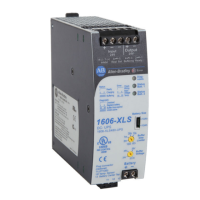Rockwell Automation Publication 1606-RM008A-EN-P - November 2021 33
DC-UPS - 24V, 20 A, 480 W Reference Manual
Recommendations for achieving a long battery service life:
• Place the batteries in a cool location. For example, near the bottom of the
control cabinet.
• Do not place the batteries near heat generating devices.
• Do not store discharged batteries.
• Do not discharge the batteries more than necessary. Set buffer time
limiter to the required buffer time.
• When choosing the batteries capacity, always try to get the next higher
capacity than required. The depth of discharge reduces the service life of
the batteries and limits the number of cycles. See Figure 27
.
How to determine the replacement intervals:
Example: - Two 26 Ah batteries with a design life of 10-12 years are used - The
average ambient temperature is 30 °C - One buffer event consumes approx.
25% of the achievable buffer time. - One buffer event every 2 days (=182 cycles /
year)
Calculation:
A) Ambient temperature influence: According to Figure 26
curve C, a 5 years
service life can be expected for an ambient temperature of 30 °C.
B) Number of discharging cycles: 5 years * 182 cycles = 910 cycles in 5 years.
According to Figure 27
, curve C has to be used (only 25% of battery capacity is
required). 910 cycles have only a negligible influence in a battery degradation
and can be ignored.
Result:
• The battery shall be replaced after five years.
• Important: The battery degrading begins from the production date
(check date code on the battery) which may shorten the replacement
intervals.
Figure 26 - Service Life Versus Ambient Temperatures, Typ.
(1)
Figure 27 - Battery Capacity Degradation vs. Discharging cycles
(1)
(1) Data provided by the battery manufacturer
20°C
10
30°C 35°C
40°C
45°C
8
6
4
2
Ambient Temperature
25°C
1
3
5
7
9
Design Life
of Battery
A: 3-5 Years
B: 6-9 Years
C: 10-12 Years
A
B
C
0
120%
100%
40%
20%
Number of Discharging Cycles
200
60%
80%
Cell Capacity
Depth of
discharge
A: 100%
B: 50%
C: 30%
400 600 800 1000 1200
A
B
C

